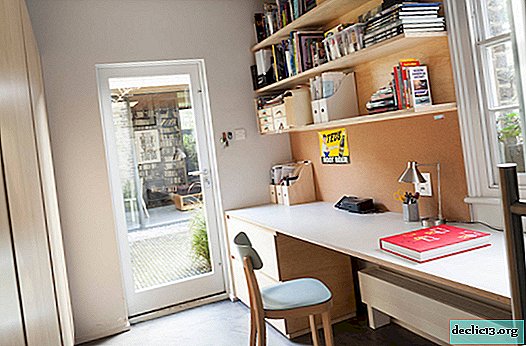Holocaust Memorial Yad Vashem - Nobody Will Be Forgotten
Yad Vashem is a Holocaust memorial complex built in honor of the courage and heroism of the Jewish people. The museum is located in Jerusalem on the Mount of Remembrance. The attraction was founded in the middle of the 20th century. The decision on the foundation of the memorial was made by the Knesset in order to preserve the memory of the Jews who became victims of fascism in the period from 1933 to 1945. The Yad Vashem Museum in Jerusalem is a tribute to and worship of people who bravely fought against fascism, those who helped the Jewish nation, heroically risked their lives. Each year, the complex accommodates more than one million tourists.

General Information About Yad Vashem - Holocaust Museum in Israel
The name of the memorial complex in Israel means "hand and name." Many peoples use the term "Holocaust", which is called the tragedy of the entire Jewish people, but in Hebrew another term is used - Shoa, which means "disaster".

Many tourists come to the Mount of Remembrance in Israel to visit the Holocaust Disaster Museum, but the attraction is a national memorial complex located on a vast territory. Many thematic objects were built here that remind young generations of the genocide of the Jewish people every minute. The museum in Israel recalls that such a thing as genocide should not be repeated.
Important! Visiting the Yad Vashem Museum in Israel is free, however, you will have to pay a nominal amount. Parking near the attraction is paid, an audio guide is also provided for 25 shekels. You also need to pay for the card.

The museum building in Jerusalem is made of concrete in the shape of an isosceles triangle. At the entrance, guests are shown a documentary about the life of the Jewish people. The interior design demonstrates the difficult atmosphere and symbolizes the difficult history of the Jewish nation during the Holocaust. The sun barely breaks through small windows. The central part of the room is completely enclosed by exhibits so that guests walk in dark galleries and are completely immersed in an atmosphere of grief.

Good to know! The Holocaust Museum in Jerusalem has ten thematic galleries, each dedicated to a specific historical stage in the life of the Jewish people. It is forbidden to take pictures in the halls.

First gallery tells of Hitler’s seizure of power, plans to seize the world, the Nazi political program. Here are the terrible facts of what Hitler planned to do with the Jewish people. The exhibits clearly show how the life of Germany changed during the years of the domination of fascism - a democratic republic was transformed into a totalitarian state in just a few years.
The subsequent rooms are dedicated to the period of World War II, special attention is paid to the capture of neighboring countries, the extermination of Jews.

Interesting fact! In Europe, the Germans created more than one thousand ghettos.
One gallery is dedicated to the ghetto in Warsaw. Reproduced the main street of the ghetto - Leszno. Here the main events in the life of the Jewish people took place. Museum guests can walk along the cobblestones, see the car in which the corpses were transported. All exhibits are real, brought from the capital of Poland. This hall contains a unique document - an order for the forcible eviction of Jews in the ghetto during the Holocaust. The document says that the creation of the ghetto is only one of the stages of the plan, and the ultimate goal is to completely exterminate the Jewish people.

The next hall of the museum about the Holocaust in Israel is dedicated to the stage of creating concentration camps. Most of the exposure is information about Auschwitz. Among the exhibits there is camp clothing, there is even a carriage where Jewish people were transported. Part of the exhibition is dedicated to the largest concentration camp - Auschwitz-Birkenau. The frame of the carriage is installed in the hall, inside of which there is a monitor, on which the memories of the surviving people who have traveled to the concentration camp are shown. Details of the fence surrounding the camp, photographs of the concentration camp, which depict the terrible process of exterminating people, are also presented.
Another gallery is dedicated to the brave heroes who took part in the salvation of the Jewish people. The audio guide tells what heroic actions people went to, how many people were saved.

Another thematic gallery is the Hall of Names. It lists more than three million names and surnames of people who became victims of the fascist regime during the Holocaust. Information was collected from relatives of the victims. Black folders are fixed on the walls, they contain original historical documents with witness testimonies, a detailed description of the lives of dead people. A huge cone is cut down in the hall right in the stone. Its height is 10 meters, depth is 7 meters. The foundation pit is flooded with water, it reflects 600 photos of Jews who became victims of the Nazis. There is a computer center in this room, information about those who died during the Holocaust is stored here. Visitors can contact the Center staff who will find data about the person.

The Epilogue Hall in the Museum in Israel is the only room in the museum complex, where special attention is focused on emotions and feelings. The walls show the stories of the dead, excerpts from memoirs, diaries.
Interesting fact! The museum ends with an observation deck, from which Jerusalem is clearly visible. The platform symbolizes the end of the difficult path when freedom and lightness come.

A memorial to the millions of children who were killed during the Holocaust in concentration camps was opened in Yad Vashem in Jerusalem. The attraction in the cave is located, daylight hardly reaches here. Lighting is created by lighted candles reflected in mirrors. The record lists the names of the children, the age when the child died. Many tourists note that it is very difficult to be in this hall for a long time.

On the territory of the museum about the Holocaust in Israel there is a synagogue where they conduct services and commemorate the dead.

The museum part dedicated to the Holocaust has the largest collection of unique, copyrighted items, photographs, documents telling about the terrible pages of the history of the Jewish people. Art objects created by prisoners in concentration camps, ghettos are exhibited here. In the exhibition halls there are permanent and temporary expositions, access to archival documents, video materials is possible.
Important! The work schedule of the Yad Vashem Holocaust Museum in Jerusalem: Sunday-Wednesday - from 9-00 to 17-00, Thursday - from 09-00 to 20-00, Friday - from 9-00 to 14-00.
Other objects of the Holocaust memorial in Israel:

- obelisk to soldiers;
- alley - trees were planted in honor of ordinary people who, at the risk of their lives, voluntarily rescued, hid Jews, risked their lives, plants were planted by savior, relatives of the victims;
- a monument to the soldiers who rebuffed the invaders organized an uprising;
- monument to the soldiers;
- Janusz Korczak Square - a sculpture of the famous Polish teacher, doctor, writer Heinrich Goldschmidt is installed here, he saved children from the Nazis, voluntarily accepted death;
- Valley of Communities - located in the western part of the complex in Israel, there are more than one hundred walls that list five thousand communities destroyed by the Nazis during the Holocaust, in the House of Commons, themed exhibitions are held here.
Good to know! Especially impressionable and receptive people are not recommended to visit the museum.
At the memorial complex in Israel, an institute for the study of the Holocaust and the genocide of the Jewish people operates. The task of the institute’s employees is to talk about the tragedy and not to let the world forget about this terrible phenomenon.
Rules for Visiting the Yad Vashem Holocaust Memorial in Israel

Entrance to the historic Holocaust complex in Israel is permitted for visitors over 10 years old. Tourists with young children can visit other exhibits and objects.
There are certain restrictions on the territory:
- it is forbidden to enter with large bags;
- no entry in bright, defiant clothing;
- in the galleries you can not make noise;
- The museum is prohibited shooting;
- it is forbidden to enter the room with food.
Entrance to the museum ends an hour before the closure of the memorial complex.Find out RATES or book any accommodation using this form
Practical information
Museum Schedule Yad Vashem- Sunday to Wednesday: from 8-30 to 17-00;
- Thursday: from 8-30 to 20-00;
- Friday, holidays: from 8-30 to 14-00.

Important! The Yad Vashem memorial complex is closed on Saturday, on holidays.
The reading room welcomes guests from Sunday to Thursday from 8-30 to 17-00. Orders for archival documents and books are accepted until 15-00.
InfrastructureThere is an information center in Yad Vashem in Jerusalem; they will provide detailed information on exhibitions and opening hours. You can eat in the cafe, which serves kosher cuisine (on the lower floor of the information center), in the milk cafeteria. The store provides thematic literature, public toilets, and left-luggage office for personal belongings.
 Audio guide
Audio guideThe cost of a personal audio guide is 30 shekels. It can be purchased by every visitor to the Yad Vashem Museum in Israel. An audio guide tells tourists about the exposition, and also voices explanations for 80 monitors. Headphones are issued at the Audioguide Bureau and at the tour desk.

ExcursionsImportant! An audio guide is provided in English, Hebrew, Russian, Spanish, German, French, as well as Arabic.

You can visit the Yad Vashem memorial dedicated to the Holocaust in Jerusalem on your own, as well as as part of an excursion group. The narration is conducted in several languages. To say the tour in a specific language, just call the museum administration (phone: 972-2-6443802) or contact via the museum website. By the way, the official resource has the opportunity to choose the language in which the story is being conducted, order an audio guide and other additional options. Some exposures can be viewed online.
Compare accommodation prices using this form

If you move from the center of Jerusalem, you need to drive about 5 km in a westerly direction. The route is followed daily by public transport. The main landmark is Herzl Mountain.
Egged buses run to the museum; it is a high-speed public transport. You can take the free shuttle bus between the Yad Vashem Museum and Mount of Memory.
A light rail service also departs from Jerusalem to the museum. You need to go to the final stop. From here guests are delivered a free minibus to eight objects of the museum complex.
Important! You can enter the museum dedicated to the Holocaust from the side of the Goland crossroads, located between the descent to Ein Karem, as well as the main entrance to Mount Herzel.

Any bus heading towards Mount Herzel in Jerusalem will take you to the museum. By the way, in Jerusalem travel bus number 99, which brings Israeli guests directly to the museum.
If you travel by car, leave the vehicle in the underground parking, you will have to pay for this service. Tourist buses stop at the entrance to the Yad Vashem memorial.
The Yad Vashem Holocaust Museum in Jerusalem is very large, before you go visit the official resource www.yadvashem.org/yv/ru/index.asp, get acquainted with useful information, the location of the main objects. For sightseeing in Jerusalem, you can safely allocate about three hours.

















